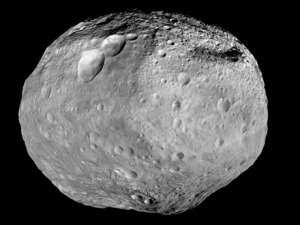Sep 30 2013
Tantalized by images from NASA's Hubble Space Telescope and ground-based data, scientists thought the giant asteroid Vesta deserved a closer look. They got a chance to do that in 2011 and 2012, when NASA's Dawn spacecraft orbited the giant asteroid, and they were able to check earlier conclusions.
A new study involving Dawn's observations during that time period demonstrates how this relationship works with Hubble and ground-based telescopes to clarify our understanding of a solar system object.
 As NASA's Dawn spacecraft takes off for its next destination, this mosaic synthesizes some of the best views the spacecraft had of the giant asteroid Vesta. Dawn studied Vesta from July 2011 to September 2012. Image credit: NASA Georgia Southern University NASA/JPL-Caltech/UCAL/MPS/DLR/IDA
As NASA's Dawn spacecraft takes off for its next destination, this mosaic synthesizes some of the best views the spacecraft had of the giant asteroid Vesta. Dawn studied Vesta from July 2011 to September 2012. Image credit: NASA Georgia Southern University NASA/JPL-Caltech/UCAL/MPS/DLR/IDA
"Since the vast majority of asteroids can only be studied remotely by ground-based and space-based facilities, confirming the accuracy of such observations using in-situ measurements is important to our exploration of the solar system," said Vishnu Reddy, the lead author of a paper published recently in the journal Icarus. Reddy is based at the Planetary Science Institute in Tucson, Ariz., and the Max Planck Institute for Solar System Research in Katlenburg-Lindau, Germany.
In the paper, Reddy and other members of Dawn's framing camera team describe how up-close observations of Vesta have confirmed and provided new insights into more than 200 years of Earth-based observations.
Vesta, the second most massive asteroid in the main asteroid belt, differs from most garden-variety asteroids in having a crust, mantle and core like our Earth. Early ground-based observations of Vesta, which was discovered in 1807, showed that Vesta's color and surface composition changed as it rotated around its axis. Astronomers using NASA's Infrared Telescope Facility at Mauna Kea in Hawaii saw distinct compositional units. It wasn't until Dawn arrived at Vesta that scientists determined the fine details and the exact distribution of these color variations, and the difference in composition between these regions.
"A generation of scientific questions framed on the basis of lower-resolution data have been resolved by visiting Vesta with Dawn," said Dawn Principal Investigator Christopher Russell, who is based at the University of California, Los Angeles. "We chose to go to Vesta because the ground-based telescopes and, later, Hubble told us it was an interesting place. That was true, but we needed Dawn to discern the mineral distribution and history of Vesta's surface. We now know how these data sets tie together and complement each other. This will help us in our telescopic studies of other members of our solar system."
One particularly useful comparison for future work on asteroids or other solar system objects involves comparing Dawn's framing camera data to data from Hubble. With Hubble, astronomers first saw the giant impact basin near the south pole of Vesta and also identified numerous bright and dark features on Vesta that correspond to different compositional units. It wasn't until Dawn's framing camera provided high-resolution views of Vesta that scientists were able to see the detailed contours of the giant impact basin that came to be called Rheasilvia and saw how bright the brightest materials were and how dark the dark materials were. Dawn's observations also showed that there was an older, overlapping giant impact basin under Rheasilvia. The bright materials appear to be pristine rocks native to Vesta, while the carbon-rich dark material appears to have been brought to Vesta from afar.
"When Dawn got to Vesta, it showed us how accurate Hubble's data were about Vesta," said Planetary Science Institute research scientist Jian-Yang Li, the Dawn participating scientist who mapped out the surface of Vesta using Hubble data. "And it also showed us how Vesta was so much more interesting up-close."
Other paper co-authors include Robert Gaskell and Lucille Le Corre of the Planetary Science Institute.
Launched in 2007, Dawn orbited Vesta for more than a year, departing in September 2012. Dawn is now on its way to the dwarf planet Ceres and will arrive there in early 2015.
The Dawn mission to Vesta and Ceres is managed by NASA's Jet Propulsion Laboratory, a division of the California Institute of Technology in Pasadena, for NASA's Science Mission Directorate, Washington. The University of California, Los Angeles, is responsible for overall Dawn mission science. The Dawn framing cameras were developed and built under the leadership of the Max Planck Institute for Solar System Research, Katlenburg-Lindau, Germany; with significant contributions by DLR German Aerospace Center Institute of Planetary Research, Berlin; and in coordination with the Institute of Computer and Communication Network Engineering, Braunschweig. The framing camera project is funded by the Max Planck Society, DLR and NASA.